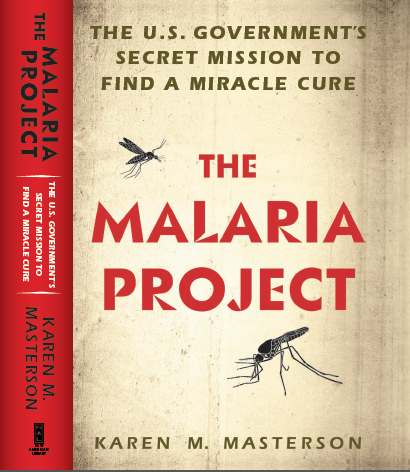The Secret Malaria Project
 Oxfam malaria prevention in Kalma refugee camp. Photo: Eva-Lotta Jansson / Oxfam America
Oxfam malaria prevention in Kalma refugee camp. Photo: Eva-Lotta Jansson / Oxfam America
Interview with Karen Masterson, author of a new book on the history of the fight against malaria.
During World War II, the government secretly organized a massive research program to find a new technology that was critical to winning to war. They borrowed heavily from German scientific discoveries and even stole Nazi materials to try to learn from them.
The atom bomb? No. Malaria.

I just read a great book on the subject by Karen Masterson. The biology of malaria and the history of the fight against it are surprisingly interesting reading and this book is really well-written. And I’m not just saying that because she’s a friend.
Malaria is still a threat to close to half the world. And while mortality rates have been declining, the World Health Organization reports that it kills more than 500,000 people a year.
I had some questions after reading the book:
Gawain: Turns out malaria is a pretty interesting disease – or maybe it’s really several diseases rather than one. What surprised you the most in learning about malaria?
Karen: I was most surprised by how easy it is to beat. Yes, it’s several diseases caused by different parasites of the genus Plasmodium. The deadliest is P. falciparum, the kind you’re likely to get in Africa. And the most widespread is P. vivax, which you’ll pick up in Asia or South America—and is notable because it hides in your liver and causes relapses. What they have in common is that both are easy to beat. Really! But it requires prevention programs and poverty alleviation. We throw $2 billion a year at developing and delivering drugs, vaccines, bed nets, and insecticides to try to reduce the disease burden; but only pennies on the dollar go to improve horrendous conditions that have people living in shacks, totally exposed to malaria’s night-feeding mosquitoes. We could prevent malaria by improving housing, for example. But treatment programs often crowd out prevention programs, and that is definitely true of malaria.
Gawain: Your book is about the top-secret WWII medical research project to stop malaria. I was reminded about the other big top-secret war project: building the atom bomb. One was successful, the other not. Is ending malaria harder than building an atom bomb?
Karen: Absolutely. The Manhattan Project scientists had it easy. All they had to do was build sophisticated weapons capable of destroying the world. Think about that. We’re now very skilled at ending life on our planet, but we are incapable of improving life for the bottom 40 percent. If we focused more on, for example, bringing good public health infrastructure to the poor, we would end malaria—and many other infectious diseases, like amoebic dysentery, cholera, TB, HIV, schistosomiasis, filariasis, leishmaniasis, African sleeping sickness, and Ebola. Because when people have good public health, they have in their communities educated professionals who understand infectious microbes and who advise communities on appropriate behaviors to control and contain outbreaks.
Gawain: My own grandfather was in the US Public Health Service during the war, and my mom got her masters in public health after medical school. So my family always held public health as a noble profession and was in thrall of the heroism and humanism. Your book profiles many of these humane heroes. But I also wonder; was that the golden age of public health? Is it all over now?

Karen: By some measures, the golden age of public health ended when pills replaced “sanitation.” Before World War II, we had some pills, but not many. Efforts to improve the public’s general health were focused on improving the human condition. After World War II, with America’s pharmaceutical industry growing exponentially, pills and vaccines replaced land reforms and anti-poverty work. Governments invested in these medical technologies as a higher priority. So we could treat the malaria infection, for example, but not touch the conditions that allowed the disease to return every time the waters ran high with mosquitoes. African countries that reached independence in the post-sanitation, take-a-pill era never had a chance. Medicine replaced traditional public health programs before they could be introduced as a political necessity. Unfortunately, medicines don’t work as well or as long when they are used in places that lack basic public health infrastructure, which, broadly defined, includes access to clean water, electricity, basic sewer systems, decent housing, and jobs.
Gawain: One of the questions of malaria that comes out in your book is the debate on whether to treat it more like a disease – with vaccines and cures – or like an environmental hazard – with screens and ditch-digging. So which is it?
Karen: Neither. Both approaches help save lives. But neither will end malaria. These parasites are a part of our environment. To me, managing malaria has got to be about economics and old-school public health. We Americans had malaria until the 1940s. We got rid of it through poverty alleviation, which Roosevelt framed as basic public health interventions (clean water, electricity, better housing, etc). We still live with environmental conditions that would support malaria—we have anopheline mosquitoes, which are the only kind that carry malaria. But we have an impeccable public health network that isolates cases brought in from overseas, so that they never spread to our mosquito populations. This is not unique to malaria. It’s true of many infectious diseases that never reach our population centers, but spread rapidly where people have no basic public health infrastructure. The most recent example of this is, of course, Ebola.
Gawain: It’s amazing to see how important the Rockefeller Foundation was to the cause of fighting malaria. Did that surprise you?
Karen: Yes! I knew very little about the Rockefeller Foundation and assumed that its public health work was designed to keep low-wage workers healthy and productive for U.S. industries. This was true of its sister organizations in Europe, which helped colonial powers overcome tropical diseases for the sake of commerce and profit. Rockefeller did a good bit of that, too, especially for the railroad and lumber industries in the South, in the early 1900s. But Rockefeller also sought to eliminate diseases like hookworm, yellow fever, and malaria for the sake of humankind—to make the world a better place. I came away with a healthy respect for the foundation’s health division.
Gawain: The book essentially records the fight against malaria through World War II – which is pretty interesting. It’s easy to forget how big and awful malaria was even in the US and Europe pre-war. Have you followed the fight since then? Is anything new in the fight?
Karen: We have a lot of new money in the fight—nearly $2 billion a year. The problem is that we haven’t had a lot of new thinking on malaria. We remain trapped in this notion that malaria is a disease that can be conquered through drugs and vaccines, primarily, and bed nets and insecticides, secondarily. But resistance to our last reliable series of drugs (the artemisinins) is already spreading rapidly. And the new malaria vaccine expected this year is only about 40 percent effective, and will be hard to administer.
I fear history is repeating itself. Before World War II, global health programs did the hard work. They sought to drain swamps, build irrigation systems and dams to reduce mosquito habitat and bring electricity to villages—which allowed for fans, which mosquitoes hate. These amenities also attracted businesses, which created jobs, which improved living standards and put people in better housing, which kept the mosquitoes out at night. Slowly, over time, the cycle of infection was broken and malaria disappeared. Then war brought us the Malaria Project. And the drugs it produced, especially the blockbuster chloroquine, replaced all this other hard work. For 15 years, from 1955 to 1970, the World Health Organization deployed chloroquine and DDT as the chief weapons in a global malaria eradication campaign. But resistance to chloroquine spread quickly, and the political will to continue dried up. We are now in our 15th year of the current attempt to eradicate malaria, and the same thing is happening. The artemisinins, which many said would end malaria, are losing their power. And we are seeing reports like Jeffery Gettleman’s recent expose that showed us how ONE BILLION bed nets western countries sent to Africa are being used: to fish. Africa waterways are being stripped of everything that can’t fit through a tight gauge net. And because these nets are impregnated with insecticide, they are poisoning water used for drinking. I am no cheerleader for the current programs.
Gawain: What’s your next project?
Karen: I’ve got two: 1) a public health history of a specific country of Africa and 2) a biography of a colorful and controversial parasitologist.